Decision Days Ahead?
by John P. Pratt
Reprinted from Meridian Magazine (21 Jun 2006).
©2006 by John P. Pratt. All rights Reserved.
Index,
Home
Each of us needs to choose, as in the times of Moses and Elijah, whether we will
serve false gods or the one true God.
With every passing day, we are being more pressured to choose whether or not we will serve the
true and living God. The days of fence-sitting seem to be swiftly drawing to a close. The U.S.
Senate just voted on whether the people of the United States of America believe in supporting the
God-given institution of marriage. When the Twin Towers were destroyed on 11 Sep 2001, many
people suddenly remembered God and news programs even encouraged public prayer rather than
reminding us that such had been ruled unconstitutional.
We often try to serve two masters. We love to live in Babylon, enjoying excessive sensual
pleasures and worshiping the god of comfort, often forgetting that sacrifice and service are the
Lord's path. We know that the city of Zion in Jackson County, Missouri, can only be built on the
law of consecration (D&C 105:5) and yet we have rejected every attempt by our prophets to prepare us for that lifestyle, including business co-ops, the united order, and even buying locally produced goods
in stores which close on the sabbath.
But the Lord makes it clear that he will not allow us to attempt to serve two masters forever. The
scriptures speak of coming days in which everyone will be required to choose whether or not we
personally will serve God. One step in that direction is that the Bible is now being classified as
"hate literature" because it teaches not to sin, which view is no longer "politically correct." We have been convinced to stop praying in public. Will we also agree to stop reading scriptures? How far can we be pushed before we take a stand?
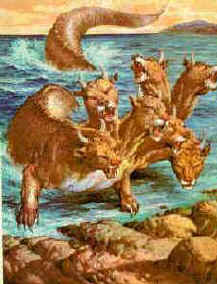 |
The seven-headed Beast from Revelation
The Book of Revelation speaks of a time when a powerful Satanic kingdom will have an
outspoken leader for three and a half years who will blaspheme the name of God and require
everyone to worship him (Rev. 13:1-8). Those who refuse to worship the image of the beast will
be executed. Everyone will need to have the mark of the beast implanted in the hand or forehead in
order to buy or sell (Rev. 13:15-17).
How about you? What would you do if faced with the decision of worshiping the image of the
beast and receiving his mark, or refusing and being executed? In case you haven't decided yet,
here are two more pieces of information to help you choose. First, those who opt to follow Satan
and receive the mark shall "drink of the wine of the wrath of God" and be "tormented with fire and
brimstone" (Rev. 14:10). Secondly, everyone is going to die anyway. The purpose of life is not to
avoid death, but rather to serve God even at the peril of death.
There have been many times in history that decisive events occurred when professed followers of
God had been sinning by worshiping false gods, when they were finally forced to decide one
way or the other. For example, when the Israelites were worshiping the golden calf, Moses required of
them, "Who is on the Lord's side?" (Ex. 32:26). Years later, when the people again were slipping
into sin, Joshua demanded, "Choose ye this day whom ye will serve" (Josh. 24:15). And Elijah
asked, "How long halt ye between two opinions? If the Lord be God, follow him: but if Baal,
then follow him" (1 Kings 18:21). He then set up an amazing contest between God and Baal to
help them decide. Let us review these and other events in detail, and the dates on which they
occurred, to see if there is a pattern which has been provided for us to understand.
 |
Moses and the Golden Calf.
1. The Golden Calf
After the children of Israel had made a covenant to serve God, they immediately forgot after Moses
was out of sight for forty days. Moses' very own brother Aaron allowed a golden calf, one of the
gods of Egypt, to be made to be worshiped. He declared the day to be a special feast day and then
they stripped naked and began to party. When Moses found out about it and returned, he was
furious. He shattered the stone tablets he had brought from the mountain and demanded that those
who were on the Lord's side would step over to stand by him. Those who did then immediately
began executing those who did not, until some three thousand golden calf advocates were slain
(Ex. 32:28). Presumably during that brief period of slaughter, many others decided to return to the
Lord's side, and soon the blood shedding ceased. Perhaps we all could use a day of decision to go
one way or the other. That was not a day for fence-sitters.
On what day did the Golden Calf event occur? The day accepted in Hebrew tradition is 17 Tammuz
which is a day of repentant fasting in the summer. That is near the time that it happened, but a
careful reading of Exodus shows that it could not have been the actual day. In an earlier paper, I
proposed an exact day for the Golden Calf incident, which turns out to be the Hebrew day 24 Tammuz.[1] That was not a special holy day at the time, nor is it a holy day now on the traditional Hebrew calendar. But on my proposed Perpetual Hebrew calendar, it is
indeed a minor holy day, being one of a set of "Decision Days," for reasons which will be
presented below.
2. Choose Ye This Day
When Joshua was nearing the end of his life, the Israelites were again forgetting their God. Shortly
before his death, Joshua challenged the people to rededicate themselves to the Lord.
After giving a wonderful review of all that God had done for them, he required of them, "Choose
ye this day whom ye will serve," the false gods of the Amorites or the Lord. They again vowed to
serve the Lord, and to be a witness of that covenant, Joshua had a large stone erected.
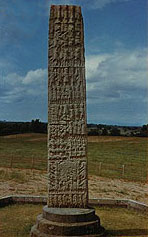 |
Joshua had a large stone erected to record Israel's covenant.
When did this happen? The Book of Jasher, which is an excellent source for dates,[2] tells us that
it occurred two years before Joshua's death, and agrees with the Bible that he died at age 110
(Josh. 24:29, Jasher 90:32,
47).
It also provides another clue, which is that Joshua was 82 years old
when he passed over the Jordan River (Jasher 88:9).
That is just barely enough information for me
to sometimes propose precise dates for those events. As has been shown in my past work, great
prophets are sometimes born on holy days on sacred calendars, and if so, then
there is usually a synchronism between their birth and death date on at least one calendar.
Moreover, as another witness, there is usually a synchronism with a key event in their life.
2.1 Joshua's Birth and Death Dates
With that in mind, it is here proposed that Joshua was probably born on Mon 16 Sep 1504 BC,
which was 1 Flint (Sacred Round), 1 Birth (Venus), 1 Creation (Mercury) and 15 Tishri (Feast of
Tabernacles on Perpetual Hebrew, or PHC). Both 1 Birth and 15 Tishri are the symbolic days of
birth on those calendars. The proposed day for his death is Fri 14 Mar 1395 BC pm*, being 1
Wind (SR), 1 Creation (V), 1 Creation (M) and 10 Nisan (PHC).[3] This has the supporting evidence
of having his birth and death on the same day of the Mercury calendar, and the death on the same
day both of Crossing the Red Sea (1 Wind) and also of Crossing Jordan (10 Nisan).
| Event | Gregorian BC | Hebrew | Sacred Round | Venus | Mercury |
| Birth | Mon 16 Sep 1504 | 15 Tishri | 1 Flint | 1 Birth | 1 Creation |
| Cross Red Sea | Tue 14 Apr 1462 pm* | 21 Nisan | 1 Wind | 1 Birth | 1 Creation |
| Enter Canaan | Sat 3 Apr 1422 | 1 Nisan | 1 Light | 1 Birth | 1 Creation |
| Cross Jordan | Mon 12 Apr 1422 | 10 Nisan | — | — | — |
| Death | Fri 14 Mar 1395 pm* | 10 Nisan | 1 Wind | 1 Creation | 1 Creation |
Table 1. Proposed Key Dates in the Life of Joshua.
Looking two years before the death of Joshua for the "Choose Ye This Day" event leads us to the date of Tue, 24 Jul 1397
BC, being 2 Ab (PHC), 1 Dragon (SR), 1 Lord (V), 1 Res (M), and 1 Midsummer (Enoch). The
day 2 Ab always falls exactly one week after 24 Tammuz on the Hebrew calendar, but it is not
recognized as a holy day. Nevertheless for reasons described below, it is proposed that it is
one of four minor holy days, being "Decision Days" in the summer.
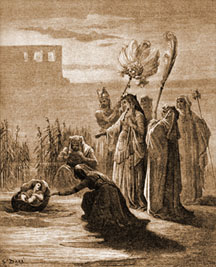 |
Moses is taken out of the water.
2.2 Moses' Birth and Translation Dates
While discussing these dates at the time of Moses and Joshua, it might be good to include also
proposed dates of birth and translation for Moses. In an earlier paper a date of birth was proposed
for Moses, but his translation date has eluded me.[4] Since that time, the workings of the Venus
and PHC calendars have become more clear, and I wish now to correct his proposed birth date by
one day on our calendar and to propose the date of his death, or rather, of his translation. It was
clear, and still is, that Moses was born on 15 Shebat, but it turns out that occurred one day earlier
than I had thought. Thus, it is proposed that he was born on Tue 21 Jan 1542 BC pm* which was
1 Flower (SR), 1 Lord (V) and the very day on the Hebrew calendar of the incredibly close conjunction of Venus and Saturn. The two planets appeared to be one, being so close that in a telescope, Venus appeared closer to Saturn than some of its own moons.
 |
Magnified view of Venus and Saturn (with moons) on Wed 22 Jan 1542 BC.
As for his translation date, the Bible actually gives it to the very day.
In Deut. 31:2 Moses declares that on that very day he was 120 years old. Then he spoke to them
and wrote a song on that "same day" (Deut. 31:22), and then he finished writing the book of the
law. Then he gathered the elders and spoke to them and quoted another song. Then the Lord
spoke to Moses on "that selfsame day" and called him up to the mountain (Deut. 31:48). He went
up into the mountain and did not return to them. Hebrew tradition is that his death occurred early in
the month of Adar, but I propose that these words of Deuteronomy be taken literally, and that
Moses was translated on his 120th birthday. That would have been Fri 15 Jan 1422 BC pm*,
being 15 Shebat (PHC), 1 Temple (SR), 1 Creation (V), 1 Birth (M). The Book of Deuteronomy
was begun to be revealed on 1 Shebat (Deut. 1:3), which was Sat 2 Jan 1422 BC, being 1 Dog
(SR), 1 Lord (V), End Watering (Jubilee), 14 Winter (Enoch) and 1 Mijamin (Priest). Thus, from
his birth to the giving of Deuteronomy complete an exact number of cycles on the Venus calendar
(1 Lord to 1 Lord) and Mercury calendar, whereas his translation date completed exactly 120 years on the Perpetual
Hebrew calendar.
| Event | Gregorian BC | Hebrew | Sacred Round | Venus | Mercury |
| Birth | Tue 21 Jan 1542 pm* | 15 Shebat | 1 Flower | 1 Lord | 14 Quick |
| Deuteronomy | Sat 2 Jan 1422 | 1 Shebat | 1 Dog | 1 Lord | 14 Quick |
| Translation | Fri 15 Jan 1422 pm* | 15 Shebat | 1 Temple | 1 Creation | 1 Birth |
Table 2. Three Proposed Key Dates in the Life of Moses.
3. Elijah: God vs. Baal
Another classic "Decision Day" occurred when Elijah set up a contest between the God of Israel
and Baal, the god of the 450 wicked priests in the days of Ahab, King of Israel. It was
designed to help the people decide to serve just one god, and in particular, the One True God.
Elijah challenged the people, "How long halt ye between two opinions? If the Lord be God,
follow him: but if Baal, then follow him!" (1 Kings 18:21). Two bulls were then sacrificed to see
which god would send fire to consume the sacrifice. The 450 priests of Baal first called upon their
god for hours to send down fire to consume their offering, but nothing happened. They apparently
were surprised at their failure and they began to cut themselves, drawing blood to encourage Baal
to come through for them.
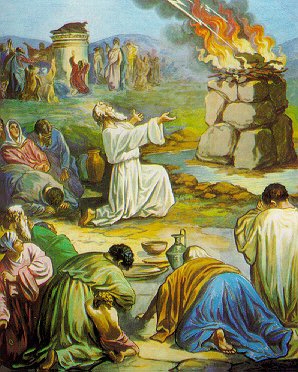 |
Elijah calls upon God.
When they had clearly failed in the eyes of all, Elijah repaired the altar of the Lord and put twelve
stones around it. He placed the offering thereon and had several barrels of water poured on it, and
a trench around the altar was also filled with water. When he called upon God, fire immediately
came down and consumed the offering, the wood, and even the stones and water in the trench.
"And when all the people saw it, they fell on their faces: and they said, The Lord, he is the God;
The Lord, he is the God." (1 Kings 18:39). The 450 priests of Baal were then executed.
The event was a climax to a long drought which had begun with the word of Elijah some three and
a half years earlier (1 Kings 17:1; Luke 4:25). Shortly after the execution, when the first little cloud
was seen, he had his servant tell Ahab to get started home before the rains prevented him from
doing so (1 Kings 18:44). Thus, the arm of the Lord was made bare before the people with both
fire and with a downpour, all happening on the same day.
So just when was that day? This date has eluded me for decades because the year in the reign of
Ahab is not given, and even the year of the beginning of his reign is not known with certainty. If I
do not have a least a year to begin searching for a day, it is usually too hard to pinpoint. As stated
above, it is best when there are two or three witnesses.
In preparing this article, it occurred to me to check historical records from neighboring countries,
for surely the drought was widespread and mentioned elsewhere. Sure enough, it is mentioned in
the Assyrian records. Those records are precisely correlated to our calendar because they mention a
total eclipse of the sun, which occurred on Mon 7 Jun 763 BC. The outstanding event for the year 882
BC is that the king brought his people home after the end of the great drought. E.W. Faulstich, the
researcher whose work pointed that out to me, placed the ending of the drought in the previous
year.[5]
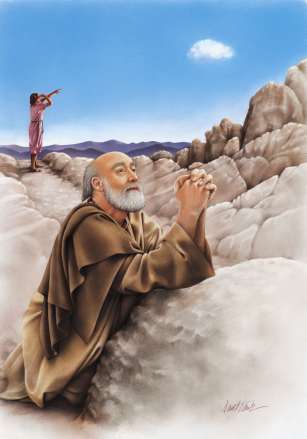 |
Elijah prays for the drought to end.
Given that year, and the above pattern that the event was very similar in nature to the Golden Calf
episode, the first date I checked in 883 BC was 24 Tammuz. It was such a perfect bull's-eye, that
it seems worthy of proposing even without other corroborating dates. The proposed date is Tue 9 Jul
883 BC, being 24 Tammuz (PHC), 13 Temple (SR), 0 Prime (V) and 0 Resurrection (M).
Moreover, it was a jubilee year, completing 11 jubilees of 49 years each since entering the
Promised Land in 1422 BC. Those are sufficient alignments to make the date jump out as
significant. Thus, we have another vote here for 24 Tammuz as being a "Decision Day."
4. Noah's Decision Days
Now let us turn to the unifying event which suggests that an entire set of four days all be classed as
"Decision Days," those days being 17 Tammuz, 24 Tammuz, 2 Ab and 9 Ab.
First, let's review the traditional Hebrew interpretation of those days. There are two fast days in
the summer which are somber occasions for remember disastrous past occasions, namely the fall
of Jerusalem (17 Tammuz) and the destruction of the temple (9 Ab). Those dates refer to both the
time of Nebuchadnezzar (587 BC) and also of Titus (AD 70).[6]. The two dates are separated by
exactly three weeks. They are sometimes referred to simply as "The Three Weeks."[7] The entire
period is a time of soberness where weddings and festivities are avoided. But as far as I know in
Jewish tradition, it is only the first and last days of that period which are considered minor holy
days. The Lord himself refers to the fasts of the fourth and fifth months (Tammuz and Ab) (Zech.
8:19).
This article proposes that two other minor holy days should be added to the list, namely 24
Tammuz and 2 Ab, which are the week-markers between the first and last holy days of the Three
Weeks. Moreover, at least the first three of those days appear to be "Decision Days," whereas the
last day (9 Ab) may symbolize the result of a poor decision made on the earlier days.
My reason for proposing that the first three are "Decision Days" comes directly from the revealed
history of Noah and the Great Deluge in Genesis. The dates of the various events have been
discussed in detail in an earlier paper, but there were four events which were skipped over quickly
because their meaning was not clear.
Noah released a raven on a day which was 40 days after 150 days after 40 days after the rain began
(Gen. 7:17; 8:3, 6, 7). Hebrew tradition places that day on 10 Tammuz, which appears to be correct. One
needs only to count the days from 17 Heshvan, when the rain was said to begin to fall.[8]. The raven went "to and fro in the earth" and did not return. Now, why was that detail included?
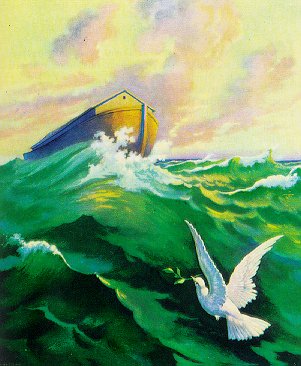 |
Dove returns with Olive Leaf on 24 Tammuz.
As was suggested in an earlier paper about the Jubilee calendar, the Deluge was apparently the
baptism of the earth, and symbolized a "rebirth." Thus, the various events noted, such as the
mountains first appearing, apparently are reminiscent of the birth of the earth, when the land first
broke out of the water and began to breath the breath of life of the atmosphere.[9] So what does a raven have to do with the birth of the earth?
4.1 Fall of Satan
Can you think of any other scripture that mentions "going to and fro in the earth"? That's right, in
the Book of Job, when Satan is asked whence he comes, he replies "From going to and fro in the
earth" (Job 1:7). Let me here suggest that there was a day when Satan was cast down to the earth
with his angels (Rev. 12:9), and that he has been going "to and fro" in the earth ever since,
tempting mankind to disobey God. Let me further suggest that the day on which he was cast down
was 10 Tammuz, symbolized by the raven having been released by Noah, and never returning.[10]
4.2 Dove Days
According to Jewish tradition, exactly one week later Noah released a dove to discover whether any
part of the earth were dry.[11] The dove returned to him that day, which would
have been 17 Tammuz (Gen. 8:8-9). One week later he released it again (on 24 Tammuz), and this
time it returned with an Olive Leaf in its beak (Gen. 8:10-11). One week later he again released the
dove (on 2 Ab) and this time, like the raven, it did not return.
Now, what is this dove episode all about? In the former article on the Jubilee calendar, while I
listed all of these precise dates in a table, it was not clear what the purpose of these doves dates
were. I merely noted them in passing, but none of them were significant on the other sacred
calendars. The dove often symbolizes the Holy Ghost, but if that is the intended symbolism this
time, then it is not at all clear to me what the meaning is.
Before going further, it was this episode which helped me pick the name "Decision Days" as a
name for this group. Clearly, Noah was making a decision on each of the three dove days. Also, it
would explain the days of Moses, Joshua, and Elijah above, when the people were all challenged
to make the decision of whether or not to follow God. But there must be something deeper. Let
us now turn to the history of Adam and Eve for a possible symbolism of the dove days.
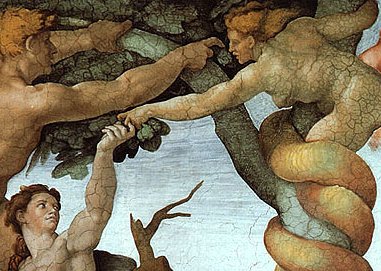 |
The temptation portrayed by Michelangelo.
5. Adam and Eve
The breakthrough in understanding the dove days was when it occurred to me that perhaps Noah
represented Adam and the dove represented Eve. What if the first day when the dove was released
represented the day on which Eve was tempted by the serpent and partook of the fruit of the Tree
of Knowledge of Good and Evil? What if the day on which the dove brought Noah an olive leaf
represented the day on which Eve brought some of the fruit to Adam? And what if the day on
which the dove was released once and for all represented the day on which Adam fell, when he
also partook of the forbidden fruit?
That might sound like a rather speculative interpretation, but let us see where it leads. First of all,
it certainly would fit with the idea of three very important "Decision Days" which affected all of the
rest of us every since. If there ever were archetypal "Decision Days," those would have been some
of the greatest examples with the most far reaching consequences.
So let us look to see if there were any days on the sacred calendars which might support this
proposal. Searching a few years before the proposed date for the expulsion from the Garden of
Eden (Sun 9 Apr 4001 BC)[12] leads to two dates which are so loaded with symbolism that they
had to be included in this article.
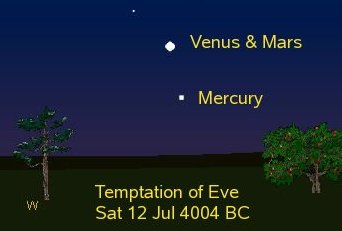 |
Mars tempts Venus on 17 Tammuz.
5.1 Fall of Eve
The day Sat 12 Jul 4004 BC was 17 Tammuz and is a perfect fit for the Fall of Eve. First, it
was 13 Serpent, the highest day of the serpent. It was the Feast of Tabernacles on the Enoch Fixed calendar, and 14 Summer (the equivalent of 17 Tammuz) on the Enoch Calendar. It was also the holy day 0 Prime on the Mercury calendar, so it was a holy day on 5 sacred calendars. But it was also the
very day of a meaningful conjunction in the heavens.
As has been pointed out in earlier papers, all of the planets are like hands on a great clock in the
sky. The twelve zodiac constellations through which all the planets move are like the 12 numbers
on the face of the clock. The slowest hands, like hour hands, are the planets Saturn, Uranus and
Neptune.[13] It turns out that during the year proposed here for the Fall of Adam and Eve, all
three of these planets are very near the star Regulus at the Heart of Leo, the Lion. That very star is
the "12 o'clock star", so the clock is set nearly perfectly for the "beginning of time." But what
about the faster moving hands, like Venus and Mars, which are like the minute hands? It turns out
that on the very day proposed here for the Fall of Eve that Venus and Mars are very near to each
other (in conjunction). They were separated only by 11 arc minutes, which is about a third of the apparent diameter of the moon. In mythology, Venus is female and Mars is the god of war, so this conjunction seems fitting symbolism for the day on which Satan tempts Eve.
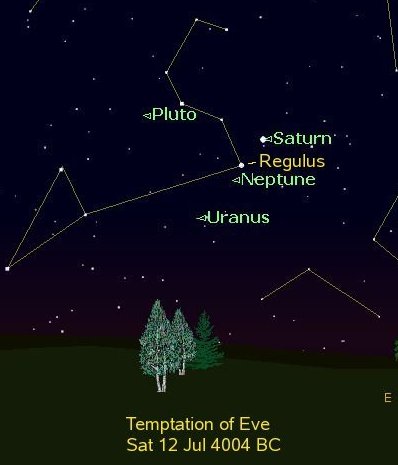 |
The slowest moving planets all near the "12 o'clock" star Regulus.
5.2 Beginning of Time
Just how unusual is it for all three great "hour hands" of the Celestial Clock to be pointing to the
"twelve" at the same time? The planets Uranus and Neptune only line up with each other every
171 years, and when they do, each successive conjunction occurs about half a constellation ahead
on the clock face. It takes 25 conjunctions of those two planets for them to meet back at
Regulus.[14] That happens in A.D. 281, but then Saturn is no where near there. At the next
conjunction, Saturn can barely squeeze into Leo with the planets Uranus and Neptune in AD 447,
but it is only a broad "grouping" because they are spread all over the constellation. For all practical
purposes, the meeting of Saturn, Uranus and Neptune at Regulus at the proposed time of the Fall
is the only time in history that the three planets are found near Regulus. Thus, the planets appear to
testify that this year, and even this very day, is correct.
5.3 Fall of Adam
According to the proposed interpretation, Eve offered the forbidden fruit to Adam one full week
after she partook of it. That is not how we generally picture it, but it seems very likely that she
might have thought a long time before telling Adam of her choice. If so, then this day (24
Tammuz) became a Decision Day for Adam, of whether he would strictly obey the Lord or go with
his wife. The day 24 Tammuz that year is holy on only one other calendar, being 21 Autumn, the
last day of Tabernacles on the Enoch Fixed Calendar. In itself, it is not a particularly impressive
date.
 |
Eve Tempts Adam.
Then Adam thinks it over for an entire week. Then he chooses also to partake of the forbidden fruit
on 2 Ab, being Sat 26 Jul 4004 BC, which is not only a holy day on five other sacred calendars,
but all of the particular holy days seem significant. The day was 1 Storm on the Sacred Round,
appropriate for representing the later consequence of being driven out from the Garden. It was
also 1 Adult on the Venus Calendar, symbolizing his loss of innocence and youth. It was 1 Death
on the Mercury calendar, symbolizing partaking of the seeds of death. Moreover, it was the first
day of the Priest cycle (1 Jehoiarib), the same as the proposed day of his birth.[15] Finally, it was
the Last Day of the Vine (Grape) Harvest on the Jubilee calendar. The significance of that comes
when one learns the Hebrew tradition that the grape was the forbidden fruit.[16] Thus, the fact that
the very day indicated by our speculative interpretation of Noah's decision days just happens to
lead to two amazing days for the Fall of both Adam and Eve, is to me compelling evidence that the
interpretation is correct.
The following table summarizes the proposed "Decision Dates."
| Event | Gregorian Date BC | PHC | Sacred Round | Venus | Mercury |
| Fall of Eve | Sat 12 Jul 4004 | 17 Tammuz | 13 Serpent | — | 0 Prime |
| Fall of Adam | Sat 26 Jul 4004 | 2 Ab | 1 Storm | 1 Adult | 1 Death |
| Golden Calf | Thu 16 Jul 1462 | 24 Tammuz | 2 Jaguar | 2 Adult | 2 Lord |
| Joshua | Tue 24 Jul 1397 | 2 Ab | 1 Dragon | 1 Lord | 1 Res |
| Elijah | Tue 9 Jul 883 | 24 Tammuz | 13 Temple | 0 Prime | 0 Res |
Table 3. Proposed Key Decision Dates in the Old Testament.
6. Joseph Smith
Now let us turn to the latter-day prophet, Joseph Smith. Did he ever have a difficult decision day,
where he had to decide if indeed he was going to follow everything that the Lord told him, or not?
There is only one incident which comes to mind, because after that one initial stumble, he never
wavered again. That incident involved the loss of the first 116 manuscript pages of his translation
of the Book of Mormon. Let us review that event and then propose a precise date for it.
 |
The Prophet Joseph Smith.
Martin Harris, who had transcribed the first part of the Book of Mormon, was anxious to show it
to his wife and friends. He had the Prophet Joseph ask the Lord for permission, but the Lord
refused. At his insistence, Joseph asked again and received the same response. One
final time Joseph asked, whereupon the Lord allowed it. Martin bound himself with a solemn
oath that he would only show certain people. The oath was broken and he failed to return to
Joseph. Finally, Joseph went to his parents' home in Palmyra and sent for Martin. When Harris
arrived, Joseph received the disastrous news that the 116 pages had been lost. According to the
prophet's mother, Lucy Mack Smith, a blight descended on Martin's wheat field that day, such that
he lost most of his crop, whereas a neighbor had no problem.[17]
The LDS Church has never recovered from this great loss; we still do not have the translation of
the Book of Lehi. The next day, Joseph received D&C 3, which chastised him for trampling the
counsel of God under foot (D&C 3:15). Clearly it was a time in which the Prophet had to think
deeply about whether or not he would henceforth obey the counsel of God perfectly.
What was the day when this occurred? In the official church history, we are told that the 116
pages were completed on Sat 14 Jun 1828.[18] Apparently Martin left with the manuscript that evening because the prophet's mother tells us that "shortly after Mr. Harris left, Joseph's wife became the mother of a son" who lived only a few hours.[19] That child
was born Sun 15 Jun 1828. The evening of 14 Jun began the day 1 Tammuz (PHC), the same day the Prophet's son was born.
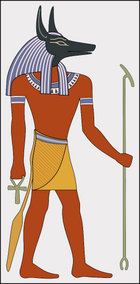 |
The Egyptian Anubis was like the Dog on the Sacred Round.
Emma nearly died also and Lucy states that Joseph cared for her until Harris had been gone nearly
three weeks. A few days afterward, Emma was well enough that Joseph went to Palmyra to find
out what had happened to Martin, which would have been about one week into July. Checking the
sacred calendars at that time leads to a date which matches the symbolism of both the Golden Calf
day and also of Elijah's contest very closely. The day Tue 8 Jul 1828 was 24 Tammuz, the same
Decision Day as proposed for both of those events. Moreover, it was 13 Dog on the Sacred
Round, where the Dog represents the day of greatest suffering for sins.[20] It was also 0 Death on
the Mercury calendar. Thus, because of this excellent fit, it is proposed that this Decision Day of
the Prophet followed the same pattern set by the ancient prophets.
Moreover, the prophet tells us that "a few days" later, after he had made his decision, that the angel
restored the Urim and Thummim to him, and he received D&C 10 and was back in good standing
before the Lord. When did that occur? If it fit this same pattern, then the likely date would have
been Tue 22 Jul 1828, 9 Ab, which was also 1 Dragon (SR) and 1 Resurrection (M), and 1
Midsummer (Enoch). If so, then it would tend to confirm the proposal that 9 Ab is not necessarily
a bad day, but rather the day on which the consequences are received for the former decisions. In
this case it was a wonderful day, for the Prophet had been reinstated to his position. The
symbolism on the Mercury calendar of 1 Death for the error and 1 Resurrection for the correction
seems especially fitting.
7. Conclusion
After having considered the dates of the great questions posed by Moses, Joshua, and Elijah to the
Israelites to choose whether or not they would serve God, it is proposed that the "Three Weeks" of
fasting and grieving on the Hebrew calendar might be more precisely interpreted as "Decision
Dates," being a time for evaluating the tragedy that sin brings and resolving to serve God. It is also
proposed, by using the dove symbolism from the Great Deluge, that the Fall of both Eve and
Adam also followed this same pattern. Even the decision of the latter-day Prophet Joseph Smith
seems to follow the same calendrical pattern. Prophecy seems to imply that we all may have some
difficult Decision Days ahead, when we too will be given a clear choice about whether to serve
God or mammon. It will be interesting to see whether or not our own Decision Days will follow
the same pattern.
Notes
- Pratt, John P., "Exodus Date Testifies of Christ" Meridian Magazine (7 Oct 2003), Section 3.2.2. In that article, I don't even mention that it was 24 Tammuz, but it is listed in my "Religious Chronology Summary. " Because 24 Tammuz, rather than 17 Tammuz is a key point in the current article, a brief review seems in order. On 1 Sivan the Israelites arrived at Mt. Sinai (Ex. 19:1). Shortly thereafter the Lord told them to prepare for two days and on the third day he would appear to Moses. That third day was the Feast of Firstfruits (Pentecost) on which there was an earthquake in the morning, with a long trumpet blast, the mountain was enveloped in smoke, and then Moses ascended it and received the Ten Commandments (Ex. 19:10-20). The traditional (Pharisee) day for Pentecost is 6 Sivan, but my understanding is that it was really the Sunday on or after that day, in this case, 8 Sivan. To me, the three days symbolized the Friday to Sunday in the Savior's life from his death to his Resurrection Sunday morning. Both the trump and earthquake are associated with the resurrection. The record then tells us that the smoke remained on the mountain for six days (Ex. 24:16) and on the seventh he called to Moses again to ascend the mount. Thus, he ascended on Sat 14 Sivan. He stayed there for 40 days, which brings the date to 24 Tammuz, Golden Calf Day, when he descended. If the Ten Commandments were given on Pentecost then the Golden Calf was not on 17 Tammuz.
- Pratt, John P., "How Did the Book of Jasher Know?" Meridian Magazine (7 Jan 2002).
- All dates are given according to our modern Gregorian calendar. The notation am* means before 6 a.m., and pm* means after 6 p.m. (when the *s are shining). The various sacred calendars mentioned are discussed in my earlier papers concerning the Sacred Round, the Venus and Mercury calendars, the Enoch calendars, and the Jubilee calendars.
- Pratt, John P., "Exodus Date Testifies of Christ" Meridian Magazine (7 Oct 2003) Section 4.1 lists the date of Moses' birth. One problem at that time was that the proposed date was one day after the big conjunction, and also one day off from a holy day
on the SR and Venus calendar. But because I did not know his translation date, it did not appear
that those calendars were involved.
- Faulstich, E.W., History, Harmony and the Hebrew Kings (Spencer, Iowa:Chronology Books
1986). Faulstich produced a detailed chronology for the entire Old Testament period, based on
computer calculations of cycles of time. I owe him a great debt of gratitude because his work has
often saved me the trouble of doing much original research. His chronology and mine both agree
that King Solomon died in 945 BC (p. 240) and they are usually with a year or so of each other
throughout the Old Testament period. Thus, while I have not yet attempted to deduce the exact
regnal years of the kings of Judah and Israel, I turned to his work to see if he attempted to date the
years of the drought. Indeed he did, basing his estimate on the Assyrian eponym year of 882 BC,
which he places in the year after the drought ended (p. 86). So again, I must thank him for the
huge amount of research which he published. He mentions the total eclipse date on p. 87.
- Lefgren, John C. & Pratt, John P., "Dead Sea Scrolls May Solve Mystery", Meridian Magazine (12 Mar 2003), Section 3. The date of the first fall of Jerusalem is given in
Jeremiah as 9 Tammuz (Jer. 39:2) rather than 17 Tammuz, and some feel that such was the original
day of the fast of the fourth month. My work has suggested that 17 Tammuz was the date on
which the first captives were taken by Nebuchadnezzar (including Daniel), and that as such it may
have been the original fast date, predating even the fall of the city. In any case, 17 Tammuz
appears to be the proper day to fast.
- Strassfeld, Michael, The Jewish Holy Days: A Guide and Commentary (New York: Harper & Row, 1985). Chapter 4 is entitled "The Three Weeks: The Dark Time."
- Pratt, John P. "Jubilee Calendar Testifies of Christ" Meridian Magazine (17 Nov 2004), Section 2.2, Table 3, lists those dates as falling on 1) Rain begins on Julian Day Count 865,982 (Sat 16 Nov 2343 BC); 2) it stops 40 days later on JD 866,022 (Thu 26 Dec); 3) Water abates 150 days later on 866,171.4 (Sat 24 May, 1 Sivan); and 4) raven released 40 days later on JD 866,211 (3 Jul, 10 Tammuz).
- Pratt, John P. "Jubilee", Section 2.2.
- The day 10 Tammuz also appears to be a minor holy day, but not in the group of Decision Days discussed in this paper. That day completes the set of four days at quarter markers for the year, being 10 Nisan, 10 Tishri, and 10 Tebeth. It may have felt like a victory for Satan to have enraged
to mob to slay the Prophet Joseph Smith on 10 Tammuz, the very day Satan was cast out. See my
"From Martyrdom to Celebration!" Meridian Magazine (17 Nov 2004), Section 4.
- The reference for the dove being first released one week after the dove is in Pratt, John P. "Jubilee", Footnote 11.
- Pratt, John P., "Venus and the Beginning of Mortality" Meridian Magazine (9 Jul 2003), Section 5.
- Pluto has a longer period, but it does not appear to be a hand on the big clock. Many astronomers today do not even count Pluto as a planet because we have since discovered several
other bodies of about the same size, such as Chiron, which are not called planets. The illustrations of conjuctions for this article were prepared with the "Starry Night Professional" computer program. It included Pluto in the illustration, so I decided to leave it there.
- Pratt, John P. "The Planets Testify of the Creator" Meridian Magazine (14 Apr 2004), Section 3.1 calculates the interval between conjunctions in
detail. A good approximation throughout history is that a conjunction occurs every 107 x 585 =
62,595 days, beginning on Tue 21 Oct 4178 BC, 1 Reed 1 (SR), being 1 Res (V) and 1 Lord (M).
With that scheme, the U/N conjunction near the Fall occurred at Wed 8 Mar 4006 BC, which
suggests that the presence of Saturn was indeed required to mark the date.
- Pratt, John P., "Mortality", Section 4.1.
- In the Apocrypha, Baruch states that an angel explained to him that the grape is the forbidden
fruit, and notes how much sorrow has come from drinking wine. He then points out that the
sacrament uses wine because of the symbolism that even as the Fall of man came from the grape,
so also does salvation (III Baruch 4:8,16-17. See Charles, R.H., The Apocrypha and Pseudepigrapha of the Old Testament London: Clarendon Press, 1913, vol II, p. 536). Note that Judah was promised that the Savior would be his descendant, who would wash his garments in the
"blood of grapes" (Gen. 49:11). In the sacrament, the Savior's blood is represented by the
blood of grapes. I thank Joyce Peabody for pointing out this entire concept to me.
- Smith, Lucy Mack, History of Joseph Smith, (Salt Lake City: Bookcraft, 1958), p. 132.
- Joseph Smith,History of the Church I: 20.
- History of Joseph Smith, p. 125
- The dog is apparently the new world equivalent of Anubis, the black jackal which in Egyptian mythology led the deceased through the depths of Hades, when great anguish was felt for sins. See also The Twenty Day Names.














